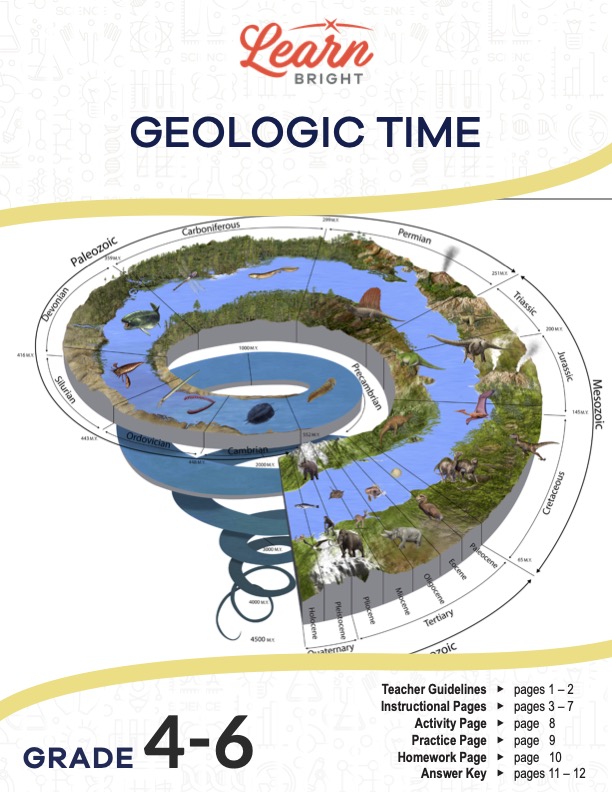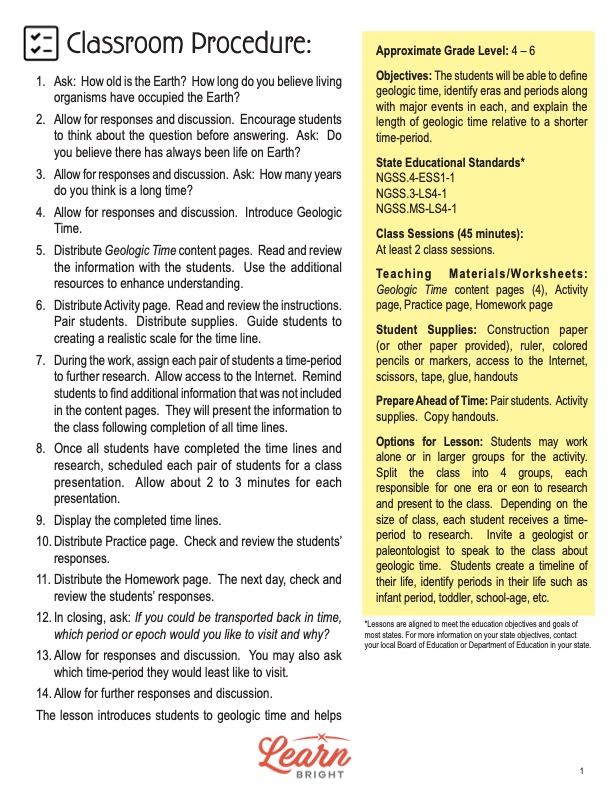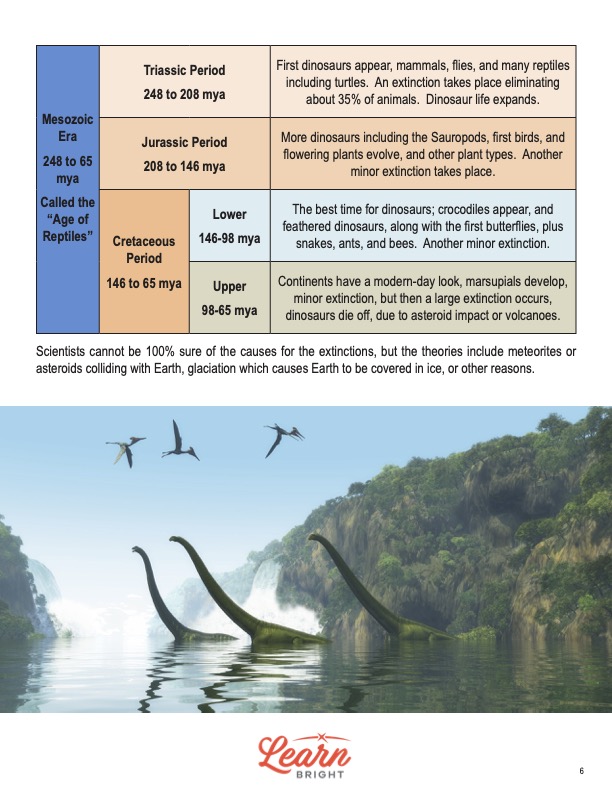Description
What our Geologic Time lesson plan includes
Lesson Objectives and Overview: Geologic Time is an excellent lesson to help students understand how scientists determine the age of the earth. Students will be able to define the term and identify eras and periods throughout Earth’s history, along with major events. They will also explain the length of geologic time relative to a shorter time period. This lesson is for students in 4th grade, 5th grade, and 6th grade.
Classroom Procedure
Every lesson plan provides you with a classroom procedure page that outlines a step-by-step guide to follow. You do not have to follow the guide exactly. The guide helps you organize the lesson and details when to hand out worksheets. It also lists information in the yellow box that you might find useful. You will find the lesson objectives, state standards, and number of class sessions the lesson should take to complete in this area. In addition, it describes the supplies you will need as well as what and how you need to prepare beforehand. For this lesson, you will need construction paper, rulers, colored pencils or markers, scissors, tape, and glue. Students will also need access to the internet.
Options for Lesson
Refer to the “Options for Lesson” section for suggestions of ideas and activities that you could incorporate into the lesson plan if you have time. If you want, students could work alone or in larger groups for the activity. Another idea is to split the class into four groups. Each one could research one era or eon and present what they discover to the class. Depending on the size of class, you could assign each student a time-period to research. Another suggestion is to invite a geologist or paleontologist to speak to the class about geologic time. As another activity, students could create a timeline of their life and identify specific periods, such as infancy, toddler, school-age, etc.
Teacher Notes
The paragraph on this page gives you a little more information on the lesson overall and describes what you may want to focus your teaching on. It suggests having students memorize the order of events depending on their age or level of ability. The blank lines are available for you to write out any thoughts or ideas you have as you prepare.
GEOLOGIC TIME LESSON PLAN CONTENT PAGES
What Is Geologic Time?
The Geologic Time lesson plan contains five pages of content. Starting off, the lesson describes time. Time is one thing that is certain to pass every day whether we want it to or not. It is a constant that existed before people roamed the earth. It never stops. In fact, the age of the earth is about 4.6 billion years old. The measurement we us to refer to the earth’s age is called geologic time.
Put another way, geologic time is the chronological time related to the events that have occurred during Earth’s history. Many scientists work to describe the timing and relationships of these events. These include geologists (people who study Earth’s matter), paleontologists (people who study Earth’s organisms), and other people in an Earth-related scientific field.
The age of the earth is very old, and its age is sometimes hard to understand. However, if spread out on a time line the size of a football field, a single yard would equal 46 million years. A single foot would only equal 15 million years. And a single inch would still equal over a million years! Using this scale, a person who is 12 years old would be represented by a tiny, microscopic dot.
Eras, Periods, and Events
The geologic time system (GTS) shows the development of Earth during its 4.6-billion-year existence. We break down that scale into eons, eras, periods, epochs, and events. There are three main eras that geologists refer to: Cenozoic, Mesozoic, and Paleozoic. And they also use the Precambrian Eon which contains three shorter eras. Eras break down into periods, some of which break down further into epochs.
Students will learn that early life began only in the seas during the Precambrian Eon (sometimes referred to as era). Algae and other organisms during this period released oxygen into the air, same as they do today. It is why the ocean’s organisms are vital for the existence of future life on Earth.
A table provides information for each of the three smaller periods during the Precambrian Eon. At the very beginning, the earth’s crust began to harden, including the oceanic crust. Later, life began to form in the sea, such as algae, bacteria, and other single-celled organisms. This is also when oxygen entered the atmosphere. Between 2.5 billion and 540 million years ago, multi-cellular life started forming, and animals appeared.
Paleozoic Era
The Paleozoic Era divides into several periods. It spans from 540 to 248 million years ago. During this era and future periods, many organisms died off and new ones came back years later. This was not unusual during the earth’s development. Extinction occurs over an extended period, and it takes many more years for organisms to appear again.
Students can learn a little about the various periods within this era using the table on this page. The Cambrian Period, for instance, occurred from 540 to 500 million years ago. Shellfish, mollusks, and other sea invertebrates started to appear, as well as the first vertebrate fish. During this time, the climate grew milder, and smaller continents began to form.
Plants began to form on land during the Ordovician Period, as well as corals and more fishes, seaweed, and fungi. Sea levels were high and there were many volcanoes around the earth. North America was under water, and many organisms became extinct due to glaciation. The Silurian Period brought the first jawed fishes, insects, vascular plants (with vessels).
One notable period is the Devonian Period, which is often referred to as the Age of Fishes. Land plants began to increase in population. The Mississippian Period was when winged insects and amphibians first came to be. And the Pennsylvanian Period yielded the first reptiles, as well as mayflies and cockroaches.
Mesozoic Era—Age of Reptiles
Many people are familiar with the Mesozoic Era because of dinosaurs, which no longer exist, of course. Scientists cannot be 100% sure of the causes for the extinctions that occurred so long ago. However, theories include meteorites colliding with the earth and glaciation, where the earth is covered in ice.
The Triassic Period predates the Jurassic Period, but this is when dinosaurs first appears, as well as mammals and more reptiles like turtles. An extinction occurred during this period that wiped out about 35% of the animals.
Then came the Jurassic Period, which brought more dinosaurs. This is also when flowering plants started to evolve. Another minor extinction took place, leading to the Cretaceous Period. This period divides into two smaller periods. The lower period was the best time for dinosaurs. Other animals that started to appear include crocodiles, feathered dinosaurs, butterflies, snakes, and bees.
The upper period happened between 98 and 65 million years ago. At this time, the continents have a modern-day look. Marsupials start to develop as well. However, a minor extinction followed by a major extinction occurred during the upper period that caused the dinosaurs to die off. Again, it is unclear what happened to cause this mass extinction.
Cenozoic Era—Age of Mammals
It was during the Cenozoic Era that the first large mammals and primitive primates started to appear on the earth. The period divides into smaller and smaller periods. Students can review the table on the last content page to better keep track of how scientists divided the years during this time.
This is also the era that the earth is currently in now, which means that it has lasted for about 65 million years so far. It is known as the Age of Mammals. The smaller period that started 1.8 million years ago is what we call the Quaternary Period, and this is what we call the Age of Man. Many of the animals that developed during this time include whales, humans, monkeys, bears, and horses.
To further understand this incredible length of time, the lesson scales down the 4.6 billion years so that a second equates to a year. With such a scale, dinosaurs lived for three weeks and became extinct just two years ago. A million years equals 12 days, and a billion years equals 31 years. And humans, then, have only existed on Earth for about 1/100 of a second.
GEOLOGIC TIME LESSON PLAN WORKSHEETS
The Geologic Time lesson plan includes three worksheets: an activity worksheet, a practice worksheet, and a homework assignment. Each one will reinforce students’ comprehension of lesson material in different ways and help them demonstrate when they learned. Use the guidelines on the classroom procedure page to determine when to distribute each worksheet to the class.
TIME LINE ACTIVITY WORKSHEET
Students will work with a partner for this activity. They will work to create a geologic pictorial time line using their own drawings or images they print from online. They will use the information from the content pages to inform where certain pictures will go. Ensure students understand that they need correct intervals between the time periods.
Depending on the scale they use, some students may need to tape or glue sheets of paper together. Initially, students will neatly label and identify each era, period, and epoch using a variety of colors and designs. Then they will draw pictures (or print images) that identify the events for each period. They should try to use as little text as possible.
After they finish, students should come up with a creative title for their time line. You will then assign a period to each pair of students to research further. Then they will discuss with each other what they learned and present the additional information they found to the class.
THE AGE OF BLANK PRACTICE WORKSHEET
The practice worksheet divides into two sections. The first section requires students to answer 18 questions or prompts related to the content pages. On the second section, they will fill in the blanks that describe each era or period in terms of the age that relates to it. For instance, the Mesozoic Era is the Age of Reptiles.
GEOLOGIC TIME HOMEWORK ASSIGNMENT
For the homework assignment, students will first order events from 1 to 10 in the order in which they occurred. The second part requires them to do the same thing with another set of events.
Worksheet Answer Keys
At the end of the lesson plan document, there are answer keys for both the practice and homework worksheets. All the correct answers are in red to make it easy for you to compare them with students’ responses. If you choose to administer the lesson pages to your students via PDF, you will need to save a new file that omits these pages. Otherwise, you can simply print out the applicable pages and keep these as reference for yourself when grading assignments.









